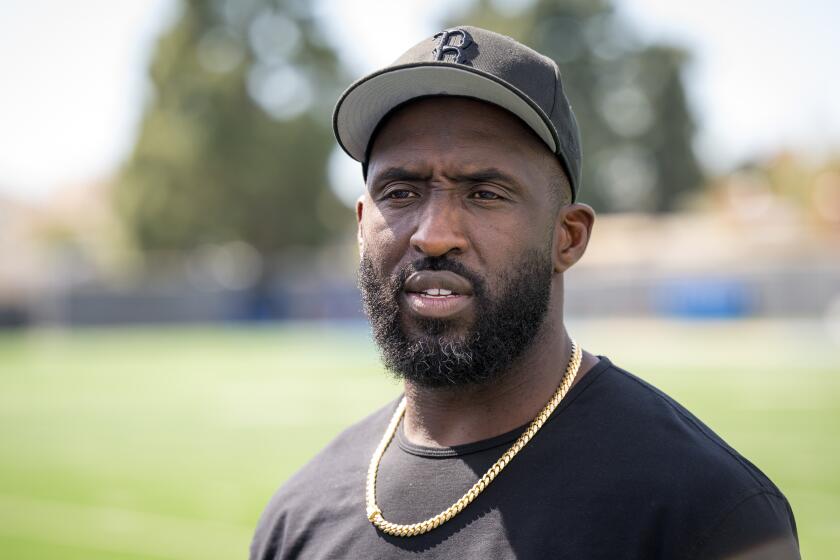Student-Athlete Notion Suffers Another Blow
- Share via
The strangest of topics worked its way into the college football discussion this week: class.
Not the social status or taxonomy or division definitions of the word. We’re talking professor, room, students. Class. Imagine that.
Oklahoma running back Adrian Peterson, the player as singularly responsible for his team’s success as anyone in college football right now, was suspended from practice and his availability for Saturday’s game at UCLA was called into question because he didn’t attend classes.
It’s not a reinforcement of the student-athlete. It’s just another in a series of reminders that the whole concept is a fallacy.
First, the Peterson case. After leading the Sooners to a victory over Tulsa on Saturday with a three-touchdown performance, Peterson was held out of two practices this week because he didn’t go to class.
After three unexcused absences in a single course per semester, Oklahoma’s Student-Athlete Code of Conduct mandates a two-day suspension from practice for the next unexcused absence in any course. Any subsequent unexcused absence is grounds for a one-game suspension.
If I’m Coach Bob Stoops, I’m buying Peterson a deluxe alarm clock. You know, with the Bose speakers and everything.
Whoops, that would probably be an NCAA violation. OK, Stoops can buy himself a nice alarm clock, then go knock on Peterson’s door every morning. For now, he’s issuing reminders to the media that, um, the student-athletes should actually do some learning and studying.
“In the end, they are here to go to school,” Stoops told local reporters. “It should be our job as administrators or coaches that if they’re not, then heck, we can’t put you on the field.”
Right. They’re there to go to school. In the end.
If academics were the priority, Stoops could exercise his authority, adopt a zero-tolerance policy and make an example of Peterson. It’s a story that would get national attention.
Except Stoops isn’t paid to educate students. He’s paid to win football games. And how do you think the Sooner faithful -- already restless after losing at home to Texas Christian in the first game -- would feel if the Sooners left the Rose Bowl with a 1-2 record and their major bowl hopes crushed? Do you think they’d be happy to see Oklahoma tumble out of the top 25 as long as the team’s grade-point average went up?
Of course not. So Peterson will be in uniform Saturday. He might not be in the backfield for Oklahoma’s first play, but we’ll see him.
I remember my first year on the Illinois basketball beat, when Coach Lou Henson disciplined a player and didn’t start him. As soon as the ball was tossed for the opening tipoff, that player was heading down the sideline to the scorer’s table to check in as soon as the first whistle blew. So much for the punishment.
At least Peterson has attended some classes. After Hurricane Katrina wrecked campuses in Louisiana, the NCAA ruled that displaced athletes could compete while attending classes at other schools or, in some cases, not enrolling at all.
It eased the extra-benefits rules to allow players to get free meals and supplies.
But it drew the line at waiving the requirement that Division I athletes sit out a year after transferring to another Division I school.
That’s not just a get-tough stance on transferring. It’s a tacit admission that players might actually be going to schools strictly for sports.
College coaches, those supposed supporters of education, are reportedly swooping in on the disadvantaged teams and trying to raid players. The NCAA’s decision is to punish the kids instead of the adults. They should let the players transfer and play immediately, then sanction the coaches if any wrongdoing is suspected.
There’s nothing wrong with teenagers and people in their early 20s wanting to play sports. The college years are a time to be selfish, to indulge in whatever they want to do. If their desire is to play sports, and the students, alumni and locals enjoy watching them do it, that’s great. And because the NFL and NBA don’t have established minor leagues, playing sports can even count as on-the-job training for the elite athletes. An internship, if you will. You can get college credit for those.
But the bottom line is these kids just want to play, at whatever school gives them the best opportunity and the biggest stage.
For the most part, they choose their schools based on which ones will offer scholarships, which coaches they like, which conference is stronger.
This ought to permanently dispel the notion that the players are doing this for Dear Old U, or that quaint idea that the college kids play for the name on the front of the uniform.
In Tulane’s case ... there is no Tulane. Technically, a university is a place that provides facilities for teaching and research. Tulane’s facilities in New Orleans are inoperable. So those who do wear the Green Wave’s uniforms will be representing a community, not a school.
If the NCAA’s emphasis were on students, it wouldn’t allow basketball teams to start games at midnight during the week or add conference championship games in Division I-A football to schedules that were supposedly too full to allow for a national playoff. The only reason the organization has academic-entry and progress-toward-degree requirements is to save itself from looking bad and prevent rampant roster-stacking by the coaches.
Among the many effects of Hurricane Katrina was the way it blew away the veneer of the connection between school and player.
And the unintended side effect of Peterson’s skipping classes was to remind us of how little the classroom has to do with the field.
*
J.A. Adande can be reached at j.a.adande@latimes.com. To read previous columns by Adande, go to latimes.com/adande.
More to Read
Go beyond the scoreboard
Get the latest on L.A.'s teams in the daily Sports Report newsletter.
You may occasionally receive promotional content from the Los Angeles Times.






